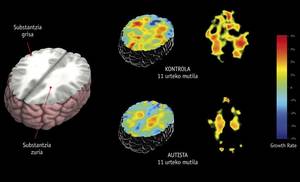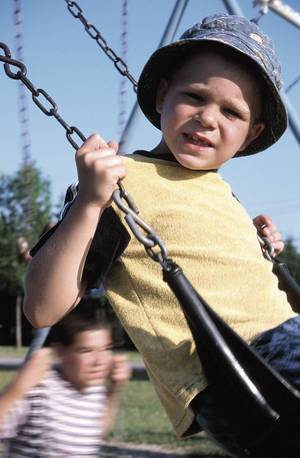AUTISM: Research opening windows
2013/07/01 Galarraga Aiestaran, Ana - Elhuyar Zientzia Iturria: Elhuyar aldizkaria

Psychiatrist Joaquin Fuentes Biggi lives the results of the research presented at the IMFAR International Autism Research Congress. And it is certain that they will influence a lot in the way they understand, diagnose and treat autism, "and that will be beneficial, not only for those who have autism, but also for their closest," Fuentes said.
Among all the studies highlights those carried out with children of a few months: "So far the diagnosis of autism was retrospective. That is, when the child is 2-3 years old, parents tell us that he does not play as much as others, that he does not look at the face, that he is behind in this or that... That is, it is limited in social and communicative capacities. From these testimonies the diagnosis is made. But instead of looking back, we are interested in diagnosing ourselves forward before the symptoms appear. Now we have information about it."
He explained that it has long been known that the parents of a child with autism have more risk than others so that, in case of having another child, he also has autism. Thus, researchers have contacted such families and have made a very demanding follow-up of the autistic brothers from the moment of their birth. Thus, it is observed that this risk is around 20%.
In any case, Fuentes warns that this percentage should be put "in quotation marks", since "the law of Dr. Jones must be taken into account. Dr. Jones was a normal U.S. pediatrician and at a congress he reached out and said that 'among my patients, when a couple has a baby with problems, they stop being a child.' That is, we don't know what the percentage would be if it didn't happen."
Despite the law of Dr. Jones, they have received data so far unknown. Thus, they realize that the brothers who have subsequently shown signs of autism have motor problems with 6 months. "Having motor problems is not at all a trait, but in any case it is new. Before we didn't even suspect it," Fuentes said.
Later, they claim that these motor problems disappear, but with 12 months others appear that are related to autism: "have social problems, pay disproportionate attention to objects and, on the other hand, have little relationship with people in their surroundings, have difficulty communicating..." These signs worsen between 12-18 months and are notorious with 24 months.
"Therefore," said Sources, "if you want to make an early diagnosis, it is not necessary to wait for the child to be 3 years old, you can advance a lot of month, since with 18 months the signs are quite clear in many cases and with 24 in almost all. With 12 it is very difficult and with 6 it is impossible."
Another aspect that has clarified the studies carried out with these children is that in the first 6 months they are like the rest. "They have no indication. We struggled to believe that. How will they have no trace? It will be that parents do not realize. But no: they have nothing special. In fact, autism is explained because from a time the brain develops differently. Symptoms appear thereafter, not before. That's why they don't notice anything until 6 months."
Search for biomarkers
However, Fuentes believes that the most "beautiful" investigations have been carried out using the technique called DTI. This technique is a variant of magnetic resonance representation that allows visualizing the diffusion of water molecules. This differentiates healthy and damaged structures.
In this way, the brain development of children with autistic siblings using DTI has been monitored and there are differences in the white substance of the brain: "That is also new to us. We have always thought that the important thing was the gray substance, but we have realized that white is also fundamental. There's nothing left in the brain."
In fact, white substance is fundamental to transmission and they have shown that autists have their problem there. Fuentes explained the importance of this study: "Those who have subsequently demonstrated autism at 6 months had abnormalities in the connections of the white substance. That is, we started to find biomarkers. This is very important because we can detect the problem before symptoms appear."
Sources have described these results as revolutionary. "Dr. Piven has conducted the research and presented the results here [at the IMFAR congress]."
He had previously published them in The American Journal of Psychychameic (June 2012). The study analyzed 92 children with high risk of autism. In addition to tracking their behavior, they investigated the development of the white substance using the DTI technique. Specifically, when they were 6 months old they were given the first test and another test when they were 12 or 24 months old.
Of these children, 28 had signs of autism with 24 months and 64 no. Analyzing the results of the DTI test, it was found that with 6 months the alterations were evident in those who were later diagnosed with autism. They concluded that autism is predictable before symptoms appear.
"That's wonderful. In fact, another study presented at the congress has shown that young children learn if they receive proper treatment. We already knew that. But even more, they have seen that in their brain activity the social response areas improve. Therefore, it is not just about learning, but that, as at those ages the brain is very plastic, we can get their brains to work better forever." For Fuentes, "it is a fundamental advance" to be able to see both alterations and improvements at the biological level.
Large umbrella
Sources, following research presented at the congress with young children, highlighted prevalence, especially a study conducted in South Korea. For the first time, the prevalence of autism spectrum was measured in a sample of the population as a whole. The title of the research is Prevalence of autism spectrum disorders in a total population sample, whose results, like those of the previous research, were published in the journal The American Journal of Psychameic (September 2011).
The novelty of the research is found in the sample selected to measure prevalence. Fuentes explained that in this type of studies the sample is a child identified in the health system. However, in this case the entire population was considered, attending schools and studying 55,000 students between 7 and 12 years old. Result: One in 38 has autism (1:38).
"Tell him. The latest measurements in the United States have obtained a prevalence of 1:88, with a difference between boys and girls of 4:1.
With the data we have here, we estimate that the prevalence is in the order of 1:150. In South Korea they thought it was 1:100. But when U.S. and Dutch researchers have changed the strategy and analyzed this broad sample of population, they have been removed 1:38," said Fuentes.
According to him, that means that within autism there is a "big umbrella": "We have at one extreme those who have hints, but who have no problem to unfold in society; and at the other, those who have truly serious problems and are highly dependent. And, among others, those who have alterations of different levels and require adequate assistance and treatment."
In fact, although in common language they are called autism, experts talk about autism spectrum disorders. "Some mixed children hardly differ from healthy children. They have normal intelligence and are not very noticeable from the behavioral point of view, as they find ways to cover their disabilities. Therefore, they do not need any special help or treatment and are very likely not to be diagnosed. However, if we analyze it specifically, we would encounter some autism spectrum disorder. There is the hill: one thing is the prevalence of mixtures, and another, those that need help."
Diagnosis for the future
Sources compare with hypertension: "What is the percentage of people with hypertension? We don't know exactly. We know how many are undergoing treatment or control, but it is possible that a person with healthy habits will never have problems with tension and that, if taken at once, has a high tension. The same goes for many other alterations and diseases."

Thus, autism is much more common than is believed. For this reason, it is no wonder that Obama has been among the three health priorities, along with cancer and aging. "In fact, the economic, social and emotional cost of autism is enormous. Some parents say your baby is as if they had kidnapped you. That is, you had a normal child until 6-8 months and you realize that it has changed... I think not noticing anything in those first months is even more painful, and we have to take it into account."
In addition, the mixtures presented are very different from each other, which makes diagnosis and treatment difficult. Fuentes explained: "I say that when you have seen a child with autism, you have seen one; and when you see another, another, and when you have seen the third, it is also one, there are three. To say that everyone has autism is like saying that everyone is from Bilbao. It is in this feature that they come together, but probably in the rest they will be completely different from each other. Therefore, the treatment must be completely personalized."
In parallel, rather than in diagnosis, Fuentes insists that we have to think about the help that the patient needs, since "the diagnosis does not say what that person needs".
In fact, the diagnostic criteria have changed right now with the appearance of a new version of the American manual (DSM-5, Diagnostic and Statistical Manual of Mental Disorders) that psychiatrists take as reference. In the autism spectrum mixtures section there are some novelties such as the new classification of Asperger syndrome. "Before, Asperger's syndrome was not part of autism spectrum disorders, but in the current classification it already appears like that."
But this is not the only change that Fuentes underlined: "the issue is that it now graduates the gravity of the problems and the help they need. That is very good, because it forces us to think not only what the diagnosis is, but what support they will need and what. So, when you leave the consultation with the parents of a child who has been diagnosed with autism, in addition to knowing the type of confusion your child has, you will know to what extent you are limited in some and other capabilities and what kind of help you need in each of them. It's an important change for me."
New medicines
The IMFAR congress has also had genetics and epigenetics, but Fuentes recognizes the difficulty of advancing in this field: "Although we know more and more the genes related to autism and sequencing is increasingly economical, there is still much to know. And there are also epigenetics, that is, to what extent the medium influences our genetic vulnerability."
In other areas, however, resounding conclusions have been drawn. "For example, in the folic acid count. They have shown that taking folic acid before, during and after pregnancy reduces the risk of having a child with autism by almost 40%," said Fuentes.
The research that demonstrates this was published last February in the American magazine JAMA. The study was conducted in Norway, with 85,176 children born between 2002 and 2008 and their mothers, and in view of the data the conclusions are clear. However, they have not found a causal effect, but they have no doubt that women who want to be mothers should take folic acid, since in addition to reducing the risk of having a bifid spine, it considerably decreases autism.
However, research related to genes has also yielded good results. Proof of this is the study done by the drug arbaclofen. This publication was published in the journal Science Translational Medicine in September 2012. Fuentes explained the core of this research: "Research to test the effectiveness of arbaclofen has been carried out to date in animals and is the first time they have tested in people. These people had fragile X syndrome, a mixture resulting from the mutation of the FMR1 gene in the long arm of the X chromosome. Well, thanks to arbaclofen, the researchers said they had fewer behavioral problems."
It seems that those with fragile X syndrome have a low activation in the synapsis of the amino acid GABA B, which causes the appearance of anxiety and other behavioral alterations. As the drug increases the production of amino acid GABA-B, which benefits patients.
According to Fuentes, the research is "remarkable", since the drugs commonly used in psychiatry are used to treat autism spectrum disorders. "These drugs soften symptoms, do not specifically treat the mixture. Now, however, we have begun to achieve this."


Gai honi buruzko eduki gehiago
Elhuyarrek garatutako teknologia








